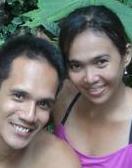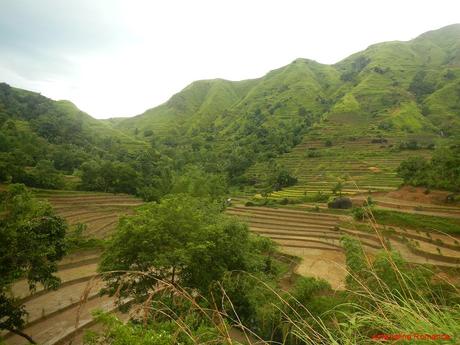
Traveling is not just about visiting destinations. If you want a truly meaningful, eye-opening trip, you have to delve down and listen to the stories of the locals. You have to appreciate and be proud of their home, history, and culture as much as they are.
During our Explore Antique familiarization tour, we had a special opportunity to visit the scenic Antique Rice terraces. More importantly, we had a tiny but knowledge-filled glimpse on their unique way of life.
Our first stop was in the town and municipality of Bugasong south of Tibiao. Bugasong is renowned for its patadyong, a kind of colorful fabric weaved through an age-old style of weaving using a hand loom. The industry, which has been established in the 18th century, is still very much alive today.
We were not able to visit the weaving facilities, but we were able to visit a culinary destination. We had brunch at Dandanzoy Restaurant, a simple and popular local outfit. Locals and tourists from all around come here to taste their specialty—the delectable buko batchoy.
A culinary innovation by Antiqueño chef Boyet Zerrudo, this delicious batchoy (a hot noodle soup made with crushed pork cracklings, pork organs, and vegetables swimming in chicken broth) is served inside a hollowed-out coconut shell. The broth contains coconut water, and the noodles are mixed with grated coconut meat. A single serving costs around P 60.
The taste, of course, is something that was totally—and pleasantly—unexpected. It was significantly milder than most batchoys we tasted. Additionally, the soup has a slightly sweet flavor to it.
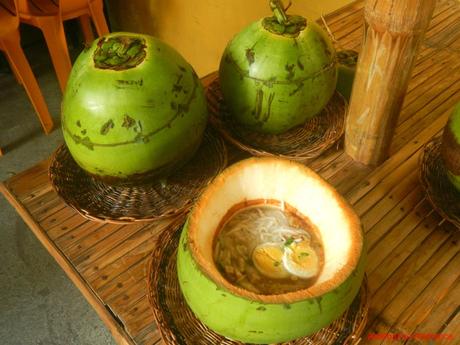
It seems that coconut is the star in this restaurant. They serve coconut burger at P40 each! Believe it or not, instead of lettuce, tomatoes, or cucumber, grated coconut is layered above the beef patty. The taste hit us right at our tickle bones and had us giggling with disbelief. It was absolutely delicious and surprising.
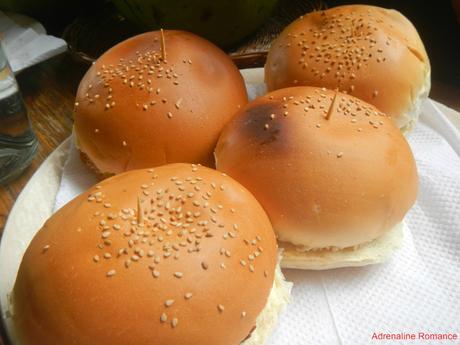
After brunch, we proceeded to our next destination, the mountainous municipality of Valderama. On the way, we cruised alongside this very impressive mountain range. We’ll tell you about our adventure there later.
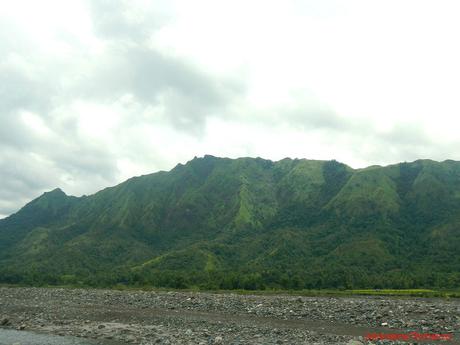
As usual, we paid a courtesy call to Valderama Mayor Jocelyn Posadas. With a police escort, we proceeded to the LGU-operated Valderama Nature Park where we had a nice lunch.
Valderama Nature Park is the jump-off to another series of adventure, one of which we will feature on the next blog post.
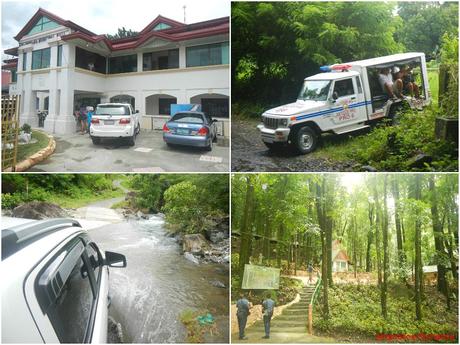
With lunch done and under the cover of ever darkening nimbus clouds, we rode habal-habals towards our inland destination. We were a little bit apprehensive, knowing that it will rain any time.
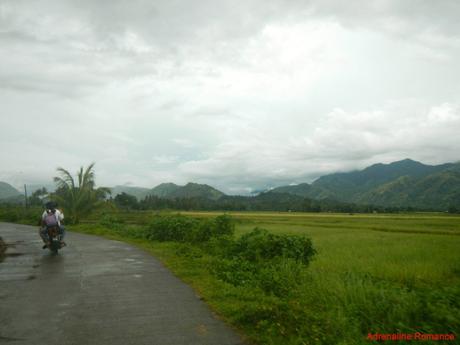
Remember that mountain range we mentioned earlier? Well, this is its “head,” the awesomely stunning Mt. Igcuron. Just look at those sharp, narrow ridges.
After our Experience Antique fam tour, Sweetie and I went back to Valderama to climb this beautiful mountain. Of course, we will tell you about it in a later post.
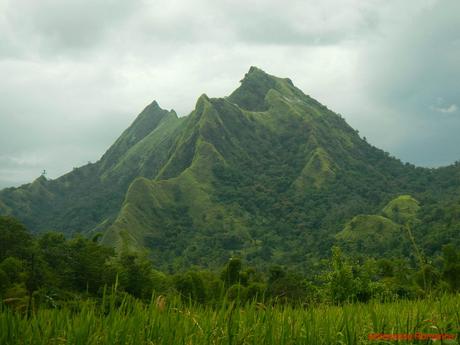
Holy guacamole! A motorcycle turned into a speedboat! Yes, you’re seeing that correctly. Habal-habal drivers push their sturdy two-wheeled machines to their absolute limit by driving them across rocky streams and rivers.
In many rural areas, the habal-habal is the most practical—sometimes, the only—way to go to places. In the hands of a skillful driver, habal-habals can go over narrow spaces and almost all kinds of terrain.

Oh, come on! You don’t say! We found out soon that crossing that fast-flowing stream was just the proverbial warm-up. A short ride later, we arrived at a shallow but wide river which we needed to cross.
During sunny days when the river is calm, flat bamboo rafts are used to transport people, motorcycles, cargo, and livestock across the waterway. However, on rainy days, using such rafts is dangerous; the current can make short work of them. Rather, “transporters” load up small, engine-less bancas with cargo.
Disbelieving our eyes while totally immersed at the sight, we watched as our habal-habal drivers carefully loaded their vehicles—two per banca—on the boat.
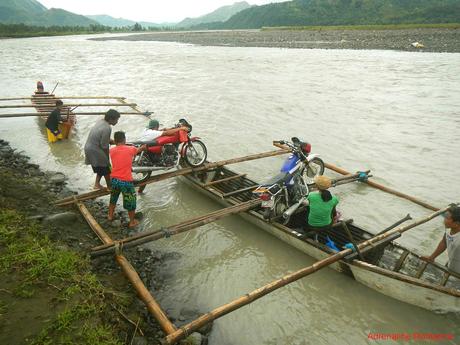
Oh, there’s still space in the banca? Then let’s put people in! Yes, this should be in the Believe It or Not archives. Our teammates’ reactions in the photo below are totally genuine.
There’s real danger here. If overloaded, water will spill into the banca. Or if one of the outriggers breaks after hitting a rock, the vessel will definitely tip over. There are no PFDs, so you better know how to swim when riding these things.
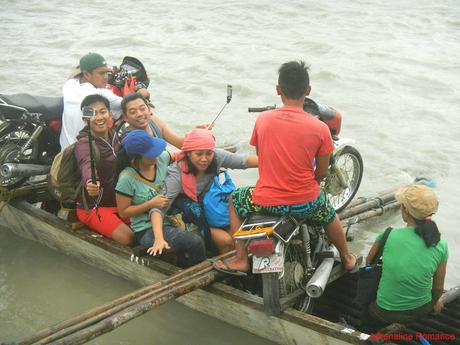
Once everyone was okay to go, the “transporters” push the boat against the current; they were able to easily do this because the water in this area is still knee-deep.
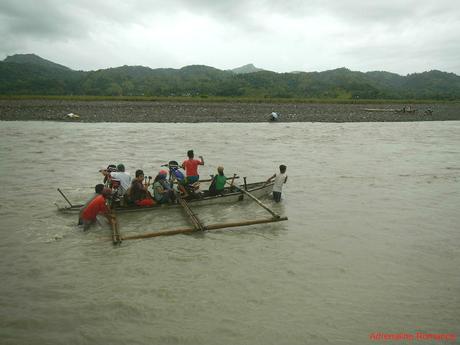
But at the last few yards of the opposite riverbank, the riverbed abruptly drops and the once manageable current rages considerably. At this point, the guys quickly jump aboard the banca, grab their oars, and raw furiously to reach the shore.
We can’t adequately describe the action in words, so we embedded this video to see just how insane this is.
At last, everyone safely crossed the waterway. But the river adventure didn’t end there. We need to ride out of the rocky riverbank to re-connect to the road. Yes, getting out of the river area was a bone-jarring ride that literally rattled our teeth.
Trucks, vans, and most four-wheeled vehicles cannot get through the large rocks and soft sand. Thus, locals carry all kinds of cargo on motorcycles, cramming them up until every inch is filled up. As you can see, this is clearly awkward—and dangerous—work.

We got back on the dirt road and proceeded to Barangay Lublub deep into the mountains. On the way, we saw huge tracts of rice plants in various stages of growth. Most of the fields here are arranged in terraces rather than checkerboard fields.

Two hours after we left the town of Valderama, we arrived at Barangay Lublub where we met our quiet and kind host and guide Tourism Officer Gina Culibao. This is the starting point of our one-hour hike to the upland barangay of Bakiang where we will spend the night.
Barangay Lublub is a trade and social hub point in this quiet part of Valderama. People congregate here to buy and sell crops, attend meetings, and chat with friends.
Despite being drenched and cold to the bone, Sweetie and I were quite excited to get this adventure rolling. Anyway, we prefer hiking in cooler weather as we don’t get exhausted easily. Hiking in hot weather dehydrates us and drains our strength.
As we hiked up the mountain, we enjoyed the lush and beautiful scenery. However, we decided to put off taking photos as the weather was gray and rainy. Hopefully, we’ll have better weather the next morning.
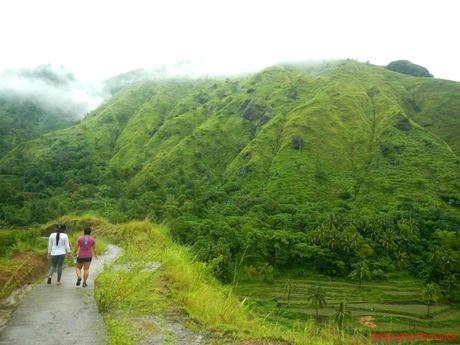
After a one-hour trek on a very muddy trail, Sweetie, Detchie, and I reached Maam Gina’s humble home in Barangay Bakiang before dark. Her home is typical of many residences in the mountains, usually made up of packed earth or bare concrete floors, amakan or hollow block walls, and galvanized steel or nipa roofs. It may seem rudimentary, but the minimal construction allows fresh mountain air to circulate freely inside. Yes, there’s no need for air conditioning. The bathroom, toilet, and kitchen are built separately from the living area and bedroom.
While waiting for the others, Maam Gina’s kids and their friends sang some nice songs that they learned in school.
An hour later, the other members of our team arrived, drenched and cold as we were. To warm us up, Maam Gina and her family prepared a steaming dinner of spicy native adobong manok and hot red bean soup. Totally delicious and filling, especially the soup!
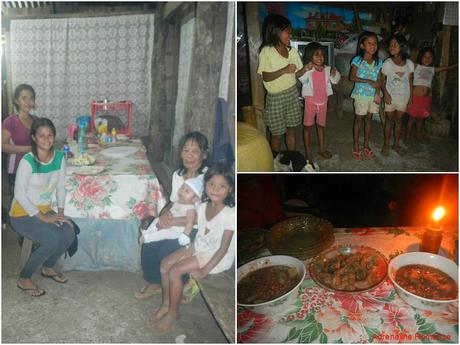
Because all of us can’t fit in Maam Gina’s house, the bloggers slept in the barangay captain’s house, which is much bigger. We all had a nice, fresh evening shower under an outdoor faucet before preparing to sleep. Our beds were beautiful native banigs (handwoven mats). There were no cushions or mattresses for our backs, but that was totally fine because the meticulously polished bamboo decks were comfortably cool.
The fresh, cool mountain air can become too cold even for locals. Thus, we kept warm by wrapping ourselves with patadyong blankets.
After a refreshing sleep, we woke up to a fairly bright morning, a welcome break faster a couple of days of non-stop rain and overcast weather.
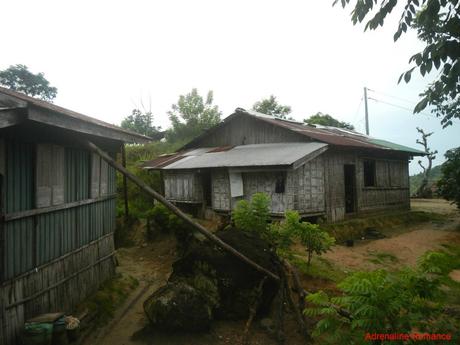
While drinking hot cups of coffee, we went out of the house to check our surroundings. We saw first-hand the huge terraces that surround us.
That cemented area is a drying platform; newly harvested rice are laid down here so they could be sun-dried. After the grains are separated through the process of milling, the husks are set aside to be used as fuel for fires.
A gang of native chickens paid us no heed as they scrounge the husks for leftover rice grains.
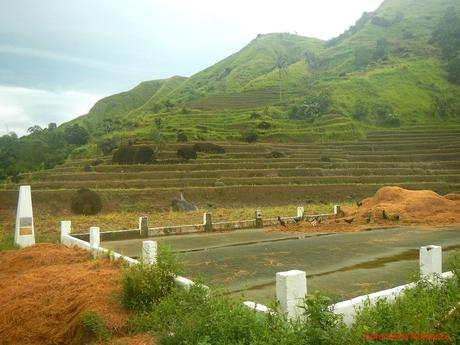
These sheds house the machines that mill the harvested rice, specifically separating the grains from the husks. We are not sure if these are gas or human powered.

Everything was quiet except for the gentle whisper of the winds, sweet songs of mountain birds, and the occasional crows of roosters. We thought that we were the first ones who were awake, but apparently, we were not. We found these two locals checking out the dams that control the flow of water from the mountain spring to the terraces.
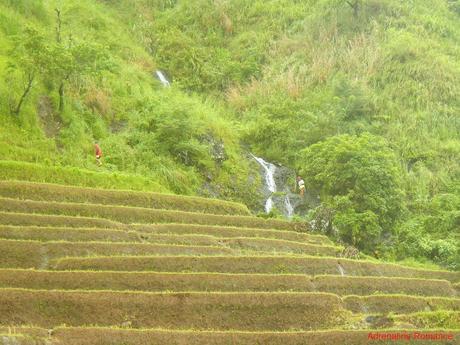
Since breakfast was still more than an hour away, we decided to explore the small mountain barangay of Bakiang. Like many small mountain villages, the community is made up of a small number of homes, perhaps numbering to a little over a dozen families. Houses, stores, and a small chapel encircle a clear field that serves as a disco floor, a basketball court, and a community center.
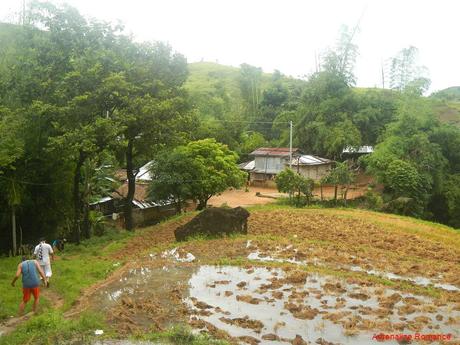
These shy kids giggled and scampered back to their small home when they saw us taking photos of them.
These kids are happy with the simplest of things. Wooden sticks, marbles, pebbles, wooden tops, and leaves will do just fine as cool, expensive toys. Games come in the form of hide and seek, tag, tsinelas lata, and tubig-tubig. Video game consoles and computers are alien to them. Looking for spiders, creating secret coves inside bamboo groves, and taking cool dips in the nearby spring are the epitome of daily fun.
We found ourselves feeling pity for “sophisticated” city children who have never experienced these simple joys. Kids whose world revolves on tablets, cellphones, video games, and TVs. Kids whose idea of fun and exercise is going to the mall.
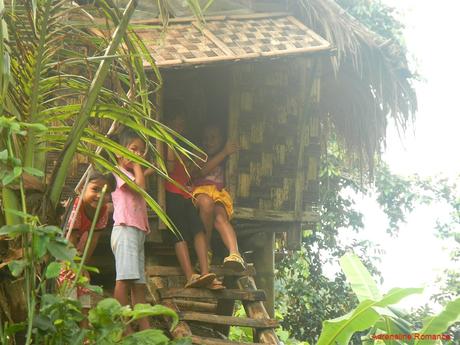
“Mahirap ang buhay sa bukid (Life is difficult in the mountains),” people often tell us. Toiling the entire day for a measly amount of income; having no modern conveniences or vehicles; consuming mostly vegetables, grains, and fruits; and walking long distances in dirt trails and jungles altogether seem to paint a picture of misery and desperation.
But for these locals, they do not treat these limitations as difficulties. As we experienced in our sojourns, they are proud of their way of life. They are extremely resilient to any natural and social crisis. They are happy and satisfied with the simplest things—food on the table, a hot cup of sinangag na kape, a glass of fresh tuba, or a roll of tobacco.
In fact, we are envious of them. They get to enjoy life to the fullest without stressing themselves to maintain status quo and financial standing. They don’t have deadlines to beat or bosses to impress. They are satisfied without modern gadgets and computers. Every day, they feast their eyes on stunning scenery, eat delicious and healthy meals, and breathe fresh air.
Haughty people of the so-called contemporary and “civilized” society has a lot to learn about the way these humble people live.
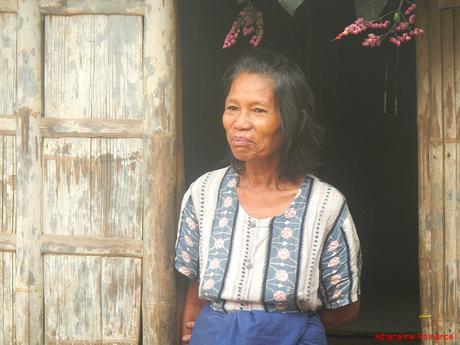
In farms and mountain villages, locals often hike on rough dirt trails that become excruciatingly dry, dusty, and hot in summer and extremely muddy and slippery during rainy season. Amazingly, they can traverse these trails wearing flip-flops or even barefoot. They even carry heavy loads on their shoulders and still move on these rough trails without difficulty!
On the other hand, we, city dwellers, need sturdy trekking shoes or sandals to grip the ground. Even then, we can only manage a slow, careful gait while locals zip easily zip around us.

Makeshift bridges made of wood and bamboo such as these span across streams. These bridges are especially useful during rainy season when the streams become too strong to safely cross through.

These natural streams form an integral part of the terraces irrigation system. They are “fueled” by waterfalls and springs high up in the mountains and jungles that surround the community. Locals dig small canals to direct the flowing water to the rice fields.
The fresh, cold water is potable, so springs like these are also sources of drinking water. It is therefore very important to keep these water sources clean.

Just look at those massive terraces! The assembly of man-made tiers looks like an ancient Roman amphitheater!
Terracing is ideal for farming hilly or mountainous areas where the soil is fertile and conducive for growing grains, vegetables, and various crops. This landscaping technique, which has been practiced since ancient times, effectively reduces surface runoff and erosion.
When we visited the Antique Rice Terraces, the terraces are mostly brown because it was just the end of the harvest season. Soon, these brown, muddy terraces will be planted with new rice plants.
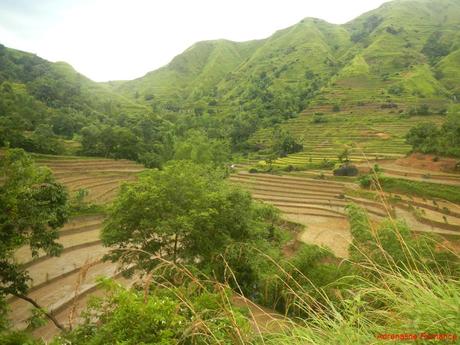
After admiring the marvels of the agricultural architecture in front of us, we went back to Maam Gina’s house to have enjoy a hot breakfast and a chat with some locals.
Soon, it was sadly time to go back to Valderama for our next destination. Exiting the village required stepping over this wooden “gate.” Hehehe!
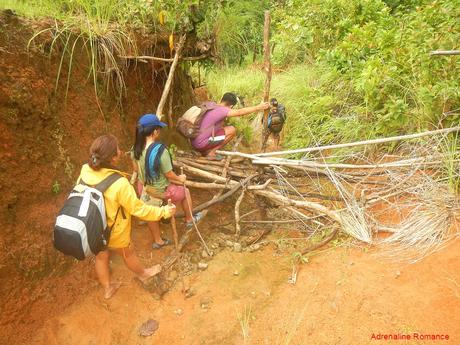
Since the weather was kind to us, we found ourselves enjoying picture-perfect scenery. Can you imagine waking up to something like this every day?
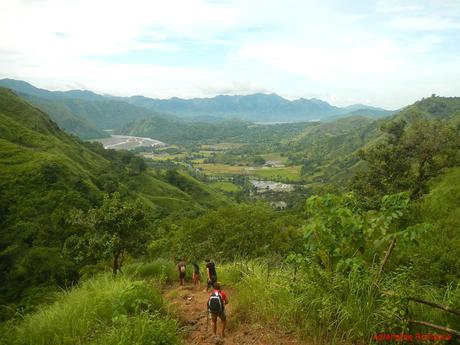
Let’s take a closer look of the Valderama valley and see why this place is perfect for farming. Large tracts of fertile land, characterized by lush forests, are cultivated into rice fields. Extensive mountain ranges and clusters of hills protect the valley from strong winds and sea breeze. Finally, the wide Valderama river acts as in important source of water for irrigation. All these features make Valerama one of Antique’s largest rice bowls.
Just recently, the National Museum shortlisted the Antique Rice Terraces as a National Cultural Treasure. This initiative was possible through the leadership of Antique Governor Dodod Cadiao and the full support of Sen. Loren Legarda, former Governor Sally Perez, UP Visayas, and all Antiqueños.
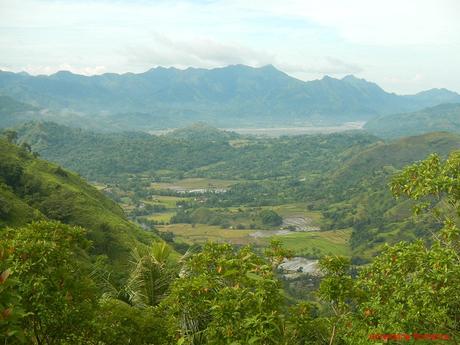
Rushing mountain springs cross the farmland trail at several points. At times, we stopped at these springs to have a drink or to wash our faces and arms with fresh, cold water.
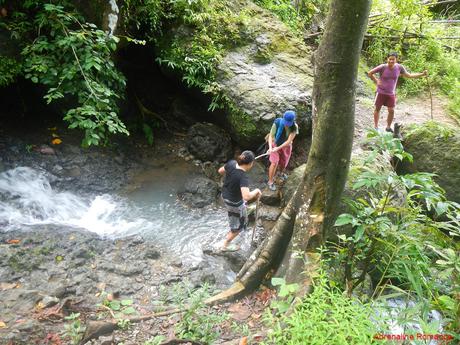
See that white, crooked line on the verdant mountainside? That is a tall, unnamed waterfall, one of the many waterfalls in the area, that provides water to the rice terraces below.
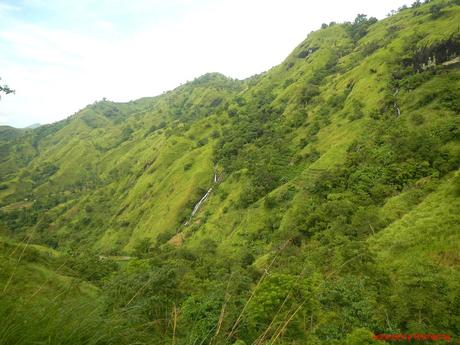
Just like in the Banaue Rice Terraces, farmers in the Antique Rice Terraces maintain the age-old practice of muyong. Muyong is the act of preserving or re-planting forests and grasslands above the rice terraces. The foliage have various purposes: they keep the soil fertilized, protect the mountainside from erosion and landslides, and act as water reservoirs to fuel springs and waterfalls.
The combination of proven farming methods, the architecture of terracing, and the muyong practice results in to an impressively efficient biorhythm. Biorhythm refers to the harmonious synchronization of cultural activities with the biology and geology of the environment.

As we went down the mountain and back to Barangay Lublub, we learned a tiny bit about the business model in the terraces. According to our guide, a farmer may own one or more terraces. For instance, as a farmer, you may own five of those terraces while we own four below yours. Small groves of trees are planted or preserved to demarcate properties.
Farmers pay a small percentage of their earnings to a local organization to maintain the terraces and to use the rice drying and milling facilities in the area.

Despite having vast tracts of land being terraced, a lot of Valderama’s hills and mountains remain green and healthy. That’s real synergy that we all can learn. Just imagine if we can design modern cities to work harmoniously with Mother Nature.

After a one-hour downhill trek, we arrived at Barangay Lublub where our habal-habal drivers were waiting for us. We rode back to the riverbank, did another crazy river crossing, and finally arrived at the municipal hall of Valderama where we had a sumptuous lunch the LGU prepared for us.
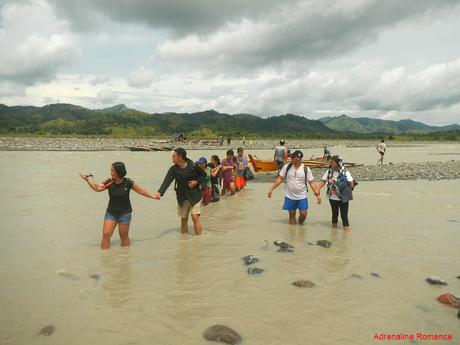
To truly know and enjoy the wonders of a certain place, you have to experience the daily life there, even for a moment. You have to genuinely connect with locals and understand their proud and unique view of their home. Appreciate what is all around you from a natural, historical, and cultural angle.
The Antique Rice terraces provides the perfect venue to immerse and learn more about life from our humble brothers and sisters who are not so far away from us.
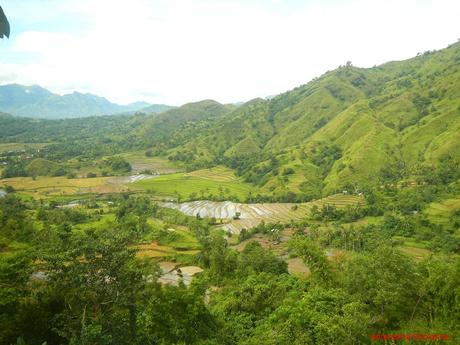
Contact Details
To facilitate your tour around Barangay Bakiang, Valderama, Antique, get in touch with the following:
- Mr. Tim Ledesma (Valderama Tourism Officer) – 0917-507-5409
- Ms. Gina Culibao (Barangay Bakiang CBT Officer) – 0927-779-0529
- Mr. Flord Calawag (OIC Antique Provincial Tourism Office) – 0927-699-5727 / 0919-813-9893
- Ms. Jola Lyn Tingson (Antique Natural Tourism Program Head) – 0977-811-0017
We strongly recommend contacting any of these officers before your trip so they can coordinate with the accommodation providers and the necessary people to help you in your cultural immersion.
Once you arrive in Valderama, head first to the municipal hall to register. Then see the tourism officer/staff for assistance.
Rates*
Transportation
- P 178 per person – bus fare from Iloilo City to Laures crossing (same rates apply on the return trip)
- P 25 per person – tricycle fare from Laures to Valderama Town Center (same rates apply on the return trip)
- P 500 per person** – round trip habal-habal fare from Valderama town center to Baranggay Lublub (includes river crossing fare for both the motorcycle and the driver)
Bakiang Related Fees
- P 50 per person – registration fee
- P 250 per group of 5 people – guide fee
- P 150 per person per night – homestay rate at Barangay Bakiang
* Rates are subject to change without prior notice. We did not include our expenses for meals, snacks, souvenirs, accommodations, tips, and other fees in this rate sheet as you may have different needs, preferences, itineraries, and sharing scheme from us.
** It can be difficult to catch a habal-habal on the return trip due to the distance and the difficulty of the terrain. Thus, make sure you arrange with the habal-habal driver to fetch you on an agreed time. We also strongly recommend asking the assistance of the Valderama tourism office to make such arrangements.
Tips
1. For large groups or for a more private tour, you can hire an air-conditioned van from Southwest Tours. Use the following contact details:
- Cellphone Numbers: 0917-568-2441 or 0947-891-1658
- Email: [email protected]
2. Stop by Dandanzoy Restaurant in Bugasong for a nice mid-day meal or merienda. Make sure you order their buko batchoy and buko burger; those are their specialties. For reservations, get in touch with Boyet Zerrudo, Restaurant Manager, at 0926-400-0751.
3. Do not expect inn, resort, or hotel-like accommodations and facilities in Barangay Bakiang. Remember, you are here for a cultural immersion experience, and you need to live like locals do. Thus, you will stay in a local’s house. Expect very basic amenities, and do not demand for anything.
4. For a minimum fee, you can have locals cook your meals for you. If you have special preferences (e.g. seafood, pasta, pork, etc.), bring the ingredients with you. Do not ask the locals to procure hard-to-find ingredients or cook complicated meals for you.
5. There is a small sari-sari store in Barangay Bakiang, but it may lack merchandise. Thus, purchase the supplies you need in Valderama or in Barangay Lublub.
6. Pack light but bring the following:
- water (at least 2 liters for the hike)
- dry clothes
- sleep clothes
- swim wear (if you wish to bathe in the mountain springs or streams)
- blanket or sleeping (if you are allergic to other fabrics)
- flip-flops
- trekking shoes or sandals with aggressive tread
- umbrella, hat, or scarf and sunglasses
- rain gear (in case of bad weather)
- extra money for emergencies
- medications (if any)
- toiletries
- snacks
7. Preserve the sanctity of the place by not throwing garbage anywhere. Do not even ask the locals to throw garbage for you. Put your trash in a plastic bag and bring it back to town for proper disposal.
